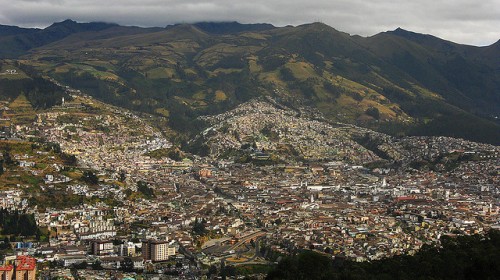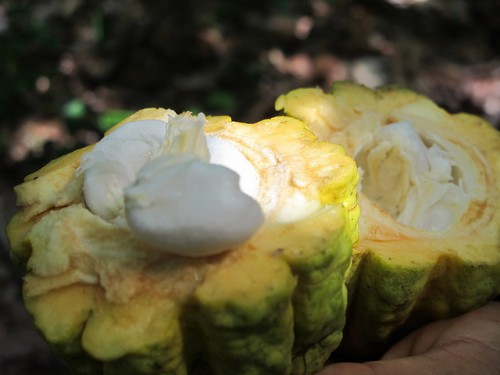Interview with Jeffrey Stern, Chocolatier and Chocolate Advocate in Quito, Ecuador, continued

Quito, Ecuador by Orban López Cruz
Jeffrey Stern is a chocolatier, chocolate advocate, entrepreneur, and blogger based in Quito, Ecuador. I recently asked Jeff to answer a long list of questions about his life and work, and he was kind enough to oblige. The first part of the interview can be read here. Below, in the second part of the interview, Jeff presents his views on standards in production, trade certifications, power relations, communication, and sharing in the chocolate world.

Fresh cacao by Mikko Koponen
Interview with Jeffrey Stern, Part 2, November 2011
Carla Martin (CDM): What standards in chocolate production do you value?
Jeffrey Stern (JM): I guess I’d have to say transparency over all. I’ll have to speak specifically to my situation in Ecuador on this first. I would love to be able to buy all chocolate made from pure Nacional beans for my production, but for both financial reasons and reasons of control, I can’t.
First off, the market here won’t bear a high cost chocolate. For example, I could buy Kallari couverture for all my chocolate making, but at $16 per kilo I’d lose money on everything I make. I just can’t pay that much for chocolate and be able to make money on it here. Unfortunately, we all have to eat.
Second, as I have discussed frequently, I can’t control what the local manufacturers’ choice of beans is and so I can’t know what beans they are using when they make chocolate. I wish I had large enough volume to have custom batches of chocolate made for my own use, but I don’t. So for local production, I buy some couverture at around $6 per kilo. If I had the volume, I’d source beans myself and have the chocolate made per my own specs. But what I buy at the lower end of the price scale is most likely mixed beans (CCN-51 and Nacional).
I do buy some pure Nacional couverture. How do I know it’s pure Nacional? I have a friend who is part owner in two large farms of pure Nacional cacao. I have been to the farms and seen them. He is Swiss, has lived here 30 years, I’ve been doing business with him nearly since I arrived five years ago, and I trust him. He has couverture made in country and sells it to me, among other people, at a fair price.
What’s important to me is to be able to know something, preferably a whole lot, about where my chocolate comes from, how it’s been produced, and what’s in it. I think the links most chocolate manufacturers state they have with the sources of their beans are tenuous at best most of the time, and certifications don’t really interest me as I don’t think they say much. It’s a paradox, but I would say the smaller, artisan chocolatiers are at both an advantage and disadvantage to the big guys. The big buyers can buy a whole farm or cooperative’s production and make a chocolate out of it and call it “Single Estate,” though that doesn’t mean it might not be mixed with other beans. But if they can’t get enough beans from one prime source, they are forced to blend. Economy of scale works both to their advantage and disadvantage. The small, artisan chocolatier can buy beans from just one or two or three prime sources, and can make a different batch of chocolate from each of those sources, which the big players can’t do because of scale problems.
I am not so much concerned with organic, Fair Trade, Rainforest Alliance, or other certifications. Here in Ecuador, to buy chocolate with any kind of certification is unfeasible price-wise for the local market. I think this is an interesting rhetorical question for consumers in the developed world to consider, too — “I can buy this ‘certified’ chocolate in the US, and yet there’s no market for it in the country of origin?” Right there is a topic to ponder.
CDM: How do you aim to share your knowledge about chocolate with others?
JS: I spend a lot of time online trying to blog, advocate, and discuss the issues facing Ecuadorian cacao, as well as many of the technical aspects of chocolate making, confectionery, etc. I don’t really focus on a global level as I don’t consider myself an expert on cacao worldwide — nor on cacao in general. But blogging only gets me so far and to a limited audience. I am hoping to get some video content online as well soon.
Fortunately, after four long and difficult years getting established in Ecuador and building a reputation as a person knowledgeable about chocolate and the industry here, I have been recognized and sought after by local businesses, especially in the travel and tourism area, and internationally. It’s unfortunate that I have to look mainly outside of Ecuador for interest in the ideas I have to share, but again, one has to make a living. I now have offerings with three different tour operators — I’ll be the guide for a four day portion of an eight day tour in February and March of 2012 with Ecuador Jungle Chocolate. The first four days will include visits to chocolate makers in Ecuador, and the second four will be focused on mushrooms with Larry Evans. I am also working with Quasar Nautica and Gentian Trails; we will have offerings of chocolate classes for tour groups, as well as tastings and visits to chocolate factories in Quito. I’ll also be meeting with and helping Sharon Lane as part of a documentary effort about chocolate in Ecuador in December 2011.
CDM: How do you communicate with other chocolate makers and chocolatiers?
JS: Most of the people I know in the chocolate community are extremely open and helpful. I use The Chocolate Life for some communication and information sharing and to help share some of my ideas. But I find my most valuable contacts are direct. Two years ago I had the opportunity to meet with Michael Recchiuti in San Francisco and spent a long Sunday morning with him, asking questions and sharing my experiences in Ecuador. Since then I’ve been fortunate enough to be able to email with him directly on many ocassions. I’ve also reached out to Christopher Elbow in Kansas City and he’s been very helpful. When I visit the US, which is almost every year, I try to take a class or two. Last year I took a class with Patrick Peeters, the head R&D Chef Chocolatier for North America at Godiva. Linkedin is also a great resource. I have been reaching out, expanding, and intensifying my efforts to stay connected with people in the US; even though I may be located in the “center” of the chocolate world in some ways, I often feel very much at the periphery of what’s going on in the world, because, let’s face it, the developed world where the money is drives the trends and shapes what happens with chocolate much more than the producers of cacao do.
I’ve also been extremely fortunate in working with Dana Brewster and Mark DelVecchio of Millcreek Cacao Roasters. They initially came to Ecuador to source cacao, hiring me as their guide. Since then, we’ve developed an excellent working relationship and we are working together on a Kickstarter project to be launched soon.
CDM: How do you understand your role or place in the chocolate world?
JS: My job as a chocolatier I wouldn’t replace for anything. While it’s totally unofficial, because chocolate is universally appreciated, I see myself as sort of an “Ambassador” for Ecuadorian chocolate and the issues surrounding it. Of course, many of the issues facing Ecuadorian cacao growers and the chocolate industry here have similar parallels elsewhere.
This summer I was at a cacao trader’s patio in El Empalme, Ecuador. He obviously moved large quantities of not only cacao, but also rice, coffee, and corn. I asked him if he exported and I was taken aback when he said no; he said he didn’t have the language ability nor the contacts to export. I think there are something like 36 official cacao exporters in Ecuador. Most of them don’t tell anyone much about what they’re doing, their business, or the issues involved. Maybe they’re too busy, they don’t want to, or they’re just not interested. There are also many cooperatives or producers’ associations in Ecuador — some do better than others at getting their stories out there. But in general, the small producer/cooperative/association is pretty much unknown. I would like to be able to remove the veil that covers the cacao trade at the ground level; too much of the business is controlled, both in economic terms and in “story” terms, by the big players and large markets.
I would love to see the day when consumers, through their pocketbooks, have influenced the other end of the cacao chain, especially the buyers, to pay a premium for pure Nacional cacao from Ecuador. A level playing field where Nacional is awarded a premium for its flavor profile and thus is once again more widely grown, despite its lower productivity and lower disease resistance than CCN-51, would be a boon for chocolate connoisseurs worldwide. It would be an amazing day if chocolate lovers worldwide would rise up in outrage like they recently have against Bank of America’s $5 debit card fees or Netflix’s plan changes! Sure, it’s not an exact parallel because these examples are about price hikes consumer don’t want; but if consumers were to respond in a similar fashion about price hikes they think farmers should get for their goods, well, this would be a radical shift in thinking.
CDM: How has travel and living abroad affected your appreciation and understanding of chocolate?
JS: I could never have learned all I know about Ecuadorian cacao and the industry here without having lived here for several years. I would never be able to understand the flavor nuances in chocolate without having tasted chocolate liquors from different farms. Now that I understand just how remote the source of much of the world’s great cacao is, it’s really amazing how it arrives all the way to your store or postbox. It arrives with such ease, and yet there is still such a large disconnect, and in academic speak, market fragmentation, on the ground here in Ecuador. The market mechanisms are broken and connections between cacao producers, cacao traders on the ground here, and cacao exporters are unregulated, unstandardized, and inefficient. This means that most of the time, small producers don’t get a fair price for their cacao, quality is not awarded the premiums it should get, and rare, fine aroma cacao doesn’t get the respect and treatment it deserves.
CDM: Is your fluency in Spanish important to your work?
JS: Without Spanish, which I learned by the way as an AFS Exchange Student to Chile in 1986, I would not be where I am today. Knowing Spanish allows me to communicate directly with everyone I work with, gives me additional business opportunities, and just opens an infinite number of doors to me as both an individual and a business person that weren’t even visible before. I of course use Spanish everyday, and it has allowed me to teach, share, and attract opportunities.
——————————————————————————————————————————–
Visit Jeffrey Stern’s blog here to learn more about his adventures with chocolate just south of the equator, and follow his company Gianduja Chocolate on his website and on Facebook. Also, stay tuned for Part 3 of this interview, as well as further details on Jeff’s upcoming Kickstarter campaign — he is currently working to launch a direct trade project to promote Ecuador’s heritage Nacional cacao and benefit small farmers.
comments
Leave a Reply

